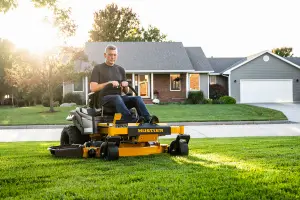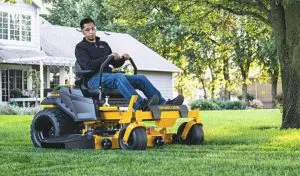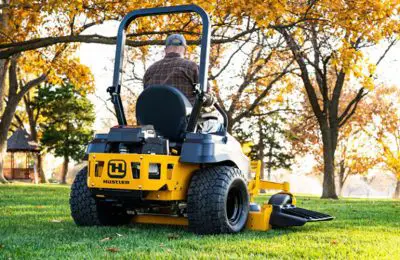When it comes to selecting the ideal zero-turn mower for your lawn care needs, a common question that arises is, “What size zero turn do I need?” Finding the right size of zero-turn mower is a crucial step in ensuring efficient mowing, precise maneuverability, and optimal performance on your lawn.
In this guide, we will delve into the factors that influence the choice of zero-turn mower size, helping you make an informed decision that results in a well-maintained and picturesque lawn. So, let’s explore the key considerations to answer the question: What size zero turn do I need?
What size zero turn mower suits my yard?

The size of the zero-turn mower you need depends on the specific requirements of your lawn or property. To determine the appropriate size, consider factors such as the total area you need to mow, the terrain, obstacles like trees and flower beds, and your budget. Zero-turn mowers come in various cutting widths, typically ranging from 30 inches to 72 inches or more.
Here are some things you need to know to make the right choice.
- Small Yard (up to 1/2 acre): A zero-turn mower with a cutting width of around 30-42 inches might be suitable for a small yard with tight spaces.
- Medium Yard (1/2 to 1 acre): A cutting width of 42-54 inches could work well for a medium-sized yard, providing efficient mowing while maneuvering around obstacles.
- Large Yard (1 to 2 acres or more): For larger yards, a zero-turn mower with a cutting width of 54 inches or more would help you cover the area more quickly.
- Commercial Use or Very Large Yard: If you have a large property or intend to use the mower for commercial purposes, you might consider a zero-turn mower with a cutting width of 60 inches or more for optimal efficiency.
It’s important to note that choosing the right size also depends on the mower’s engine power, deck construction, and other features that affect its performance and durability.
For the most accurate recommendation, I recommend consulting with a local lawn equipment dealer or a professional landscaper who can assess your specific needs and provide personalized advice based on the current availability of mower models and sizes.
How do I determine the right zero turn size?
To determine the right size of a zero-turn mower for your lawn, follow these steps:
- Measure Your Lawn: Measure the total area of your lawn. This will help you understand the scale of the task and narrow down your mower options.
- Consider Terrain and Obstacles: Take note of any slopes, uneven terrain, and obstacles like trees, flower beds, rocks, or structures. These factors will influence the maneuverability and cutting width you need.
- Cutting Width: As a general guideline, the cutting width should ideally be about half the width of your mowing area. This allows for efficient mowing without sacrificing maneuverability. For example, if you have a 60-foot-wide lawn, a mower with a 30-inch cutting width could work well.
- Mower Deck Construction: Consider the design and construction of the mower’s deck. Some decks are better suited for certain terrain types and grass conditions. A deeper deck might be better for tall or thick grass, while a shallower deck might be more suitable for manicured lawns.
- Engine Power: The engine power of the mower is important for both performance and mowing speed. A larger engine can handle tough conditions more effectively, but it might also consume more fuel.
- Brand and Model: Research different brands and models of zero-turn mowers. Read reviews, compare features, and consider the reputation of the manufacturer.
- Budget: Set a budget for your mower purchase. Keep in mind that larger mowers with more features tend to be more expensive.
- Consult Experts: If you’re unsure about the right size, consult with experts. Visit local lawn equipment dealers, talk to professional landscapers, or seek advice from friends or neighbors who have experience with zero-turn mowers.
- Test Drive: If possible, test drive different mowers before making a decision. This will give you a feel for how they handle, turn, and maneuver.
- Maintenance and Storage: Consider where you’ll store the mower and how easy it is to access and maintain. Some larger mowers might require more storage space and maintenance.
- Future Growth: Think about future changes to your lawn. If you plan to expand your lawn or make significant changes, consider a mower that can handle the anticipated changes.
Remember that choosing the right zero-turn mower size is about finding the right balance between efficiency, maneuverability, and performance. It’s a decision that depends on your specific needs and preferences, so take the time to research and make an informed choice.
What factors impact the ideal zero turn size?

The ideal size of a zero-turn mower is influenced by various factors that relate to your lawn’s characteristics, your mowing needs, and your personal preferences. Here are the key factors that impact the ideal zero-turn mower size:
- Lawn Size: The total area of your lawn is a crucial factor. Smaller lawns can be efficiently mowed with narrower cutting widths, while larger lawns require wider decks for faster mowing.
- Terrain and Topography: Consider the terrain of your lawn. If you have steep slopes, rough terrain, or uneven surfaces, you might need a mower with better stability and traction. A larger deck can help cover uneven ground more effectively.
- Obstacles and Landscape Features: Take note of obstacles such as trees, flower beds, rocks, and structures. A larger mower might struggle to navigate tight spaces, so ensure the mower’s size allows for easy maneuvering around obstacles.
- Maneuverability: Zero-turn mowers are known for their excellent maneuverability. A smaller size with a compact deck allows for tighter turns and better agility, which is beneficial in lawns with intricate layouts.
- Mowing Speed: A larger cutting width allows you to cover more ground in each pass, reducing the total mowing time. However, a wider deck might sacrifice some maneuverability.
- Engine Power: The engine power influences the mower’s performance, especially when dealing with tall or thick grass. A larger engine can handle tougher conditions, but it might also consume more fuel.
- Grass Type and Condition: Different grass types have varying growth rates and densities. Consider the type of grass you have and its typical condition. Thicker or tougher grass might require a larger cutting width.
- Operator Experience: Your comfort and experience operating a zero-turn mower play a role. Some operators might prefer a smaller size for easier handling, while others might be comfortable with larger mowers.
- Budget: Your budget will determine the range of options available to you. Larger mowers with more features tend to be more expensive.
- Storage Space: Consider where you will store the mower. Larger mowers require more storage space, which might be a consideration if you have limited storage room.
- Future Landscaping Plans: If you have plans to make changes to your lawn in the future, such as adding new flower beds or removing trees, consider how your mower’s size will affect these plans.
- Commercial or Residential Use: If you’re using the mower for commercial purposes, you might need a larger and more powerful mower to handle frequent and extensive mowing tasks.
It’s important to strike a balance between cutting width, maneuverability, and other features to ensure that the zero-turn mower you choose meets your specific needs and provides efficient and effective mowing performance.
Consulting with professionals, such as lawn equipment dealers or landscapers, can also help you make an informed decision based on your unique circumstances.
What’s the recommended deck size for my zero turn?
The recommended deck size for your zero-turn mower depends on various factors, including the size of your lawn, terrain, obstacles, and personal preferences. Here’s a general guideline to help you determine an appropriate deck size based on your lawn size:
- Small Yard (up to 1/2 acre): For smaller yards, a deck size of around 30 to 42 inches can be effective. This allows for easy maneuvering around tight spaces and obstacles.
- Medium Yard (1/2 to 1 acre): A deck size of 42 to 54 inches is suitable for medium-sized yards. It strikes a good balance between maneuverability and mowing efficiency.
- Large Yard (1 to 2 acres): If you have a larger yard, consider a deck size of 54 to 60 inches. This wider cutting width helps cover more ground in each pass.
- Very Large Yard (2 acres or more): For very large yards, you might want a deck size of 60 inches or more. This size will help you complete mowing tasks more quickly.
Remember that these are general guidelines, and you should also consider other factors like terrain, obstacles, and your comfort level operating a larger mower. If your lawn has many obstacles or tight spaces, you might lean toward a smaller deck for better maneuverability.
Additionally, you may want to take into account the type of grass you have and its growth characteristics. If your grass tends to grow thick or tall, a larger deck size might be more efficient.
When deciding on the deck size, it’s a good idea to visit a local lawn equipment dealer, discuss your specific needs, and even test drive different mower models to get a feel for their maneuverability and performance.
How does yard terrain influence zero turn size choice?

Yard terrain plays a significant role in determining the appropriate size of a zero-turn mower. The terrain affects how well the mower can maneuver, how efficiently it can cut the grass, and its overall performance. Here’s how yard terrain influences the choice of zero-turn mower size:
- Slope and Steepness: If your yard has steep slopes, a smaller zero-turn mower with a lower center of gravity might be more stable and safer to operate. Wider mowers could be less maneuverable on slopes and potentially pose a tipping risk. In such cases, you might prioritize a compact size that ensures better control and safety.
- Uneven Ground: A bumpy or uneven yard requires a mower that can handle the terrain without scalping the high spots or missing the low areas. A mower with a smaller deck can better contour to the ground, ensuring an even cut.
- Obstacles and Tight Spaces: If your yard has many trees, flower beds, rocks, or other obstacles, a smaller zero-turn mower can navigate these areas more easily. Tight spaces might restrict the movement of larger mowers, leading to potential damage to both the mower and the obstacles.
- Open Areas: If you have large, open areas of relatively flat terrain, a larger zero-turn mower with a wider deck can help you cover more ground in fewer passes, increasing efficiency.
- Wet or Soft Soil: In yards with soft or wet soil, a larger mower might leave tracks or ruts that could affect the lawn’s appearance. A smaller mower distributes its weight over a smaller area, reducing the impact on the soil.
- Accessibility: Consider the accessibility of your yard. If you have narrow gates or pathways, a smaller zero-turn mower can easily fit through these spaces without causing damage.
- Maneuverability: Overall, the terrain influences the mower’s maneuverability. In challenging terrains like steep slopes or tight spaces, a smaller zero-turn mower can provide better control and maneuvering capabilities.
- Aesthetic Preferences: The terrain might also influence your aesthetic preferences. A smaller deck can provide more precision and finesse in uneven or intricate landscapes, while a larger deck might be preferred for larger open spaces.
When choosing the size of a zero-turn mower, it’s crucial to carefully assess your yard’s terrain and consider how well the mower can handle the specific challenges presented by that terrain. Consulting with experts, such as lawn equipment dealers or landscapers, can help you make an informed decision based on your yard’s unique characteristics.
Is a larger or smaller zero turn better for uneven lawns?
When dealing with uneven lawns, the choice between a larger or smaller zero-turn mower depends on the degree of unevenness, the type of terrain, and your specific preferences. Both larger and smaller zero-turn mowers have their advantages and considerations for uneven lawns:
Smaller Zero-Turn Mower:
- Maneuverability: Smaller zero-turn mowers are generally more maneuverable and can navigate uneven terrain, obstacles, and tight spaces more effectively.
- Contouring: Smaller mowers with narrower decks can better contour to the uneven ground, ensuring a more even cut on undulating surfaces.
- Stability: Smaller mowers may have better stability on slopes and uneven ground due to their lower center of gravity.
- Less Impact: Smaller mowers distribute their weight over a smaller area, potentially causing less impact and stress on the soil, especially in softer or wetter conditions.
Consideration: Smaller mowers might require more passes to cover a larger area, which could increase mowing time on bigger uneven lawns.
Larger Zero-Turn Mower:
- Efficiency: Larger zero-turn mowers with wider decks can cover more ground in each pass, potentially reducing the overall mowing time on larger uneven lawns.
- Smooth Ride: Some larger mowers are equipped with suspension systems that provide a smoother ride on rough or uneven terrain.
- Cutting Power: Larger mowers with more powerful engines might handle thick or tall grass on uneven terrain more effectively.
- Deck Adjustment: Some larger mowers have adjustable decks that can adapt to different terrain heights, allowing you to achieve a more even cut.
Consideration: Larger mowers might be less maneuverable in tight spaces or around obstacles, potentially leading to missed spots or scalping on particularly uneven areas.
Ultimately, the choice between a larger or smaller zero-turn mower for uneven lawns depends on your priorities. If you value precision, maneuverability, and minimal soil impact, a smaller mower might be more suitable. If you prioritize efficiency, faster mowing on larger areas, and the potential for added features like suspension systems, a larger mower could be a better fit.
Before making a decision, it’s recommended to test drive both sizes if possible and consider consulting with professionals who can provide insights based on your specific lawn characteristics and needs.
Top pick for you:
Conclusion
You will get to learn more about what size zero turn do i need on this page. The size of the zero-turn mower you need depends on factors like the size of the properties you’ll be mowing, the type of work you’ll be doing, and your budget. Generally, professionals often opt for deck sizes ranging from 48 to 72 inches.
Smaller decks are suitable for residential properties and tight spaces, while larger decks are more efficient for commercial or larger open areas. Consider your specific requirements and consult with experts to determine the most suitable zero-turn mower size for your tasks.


